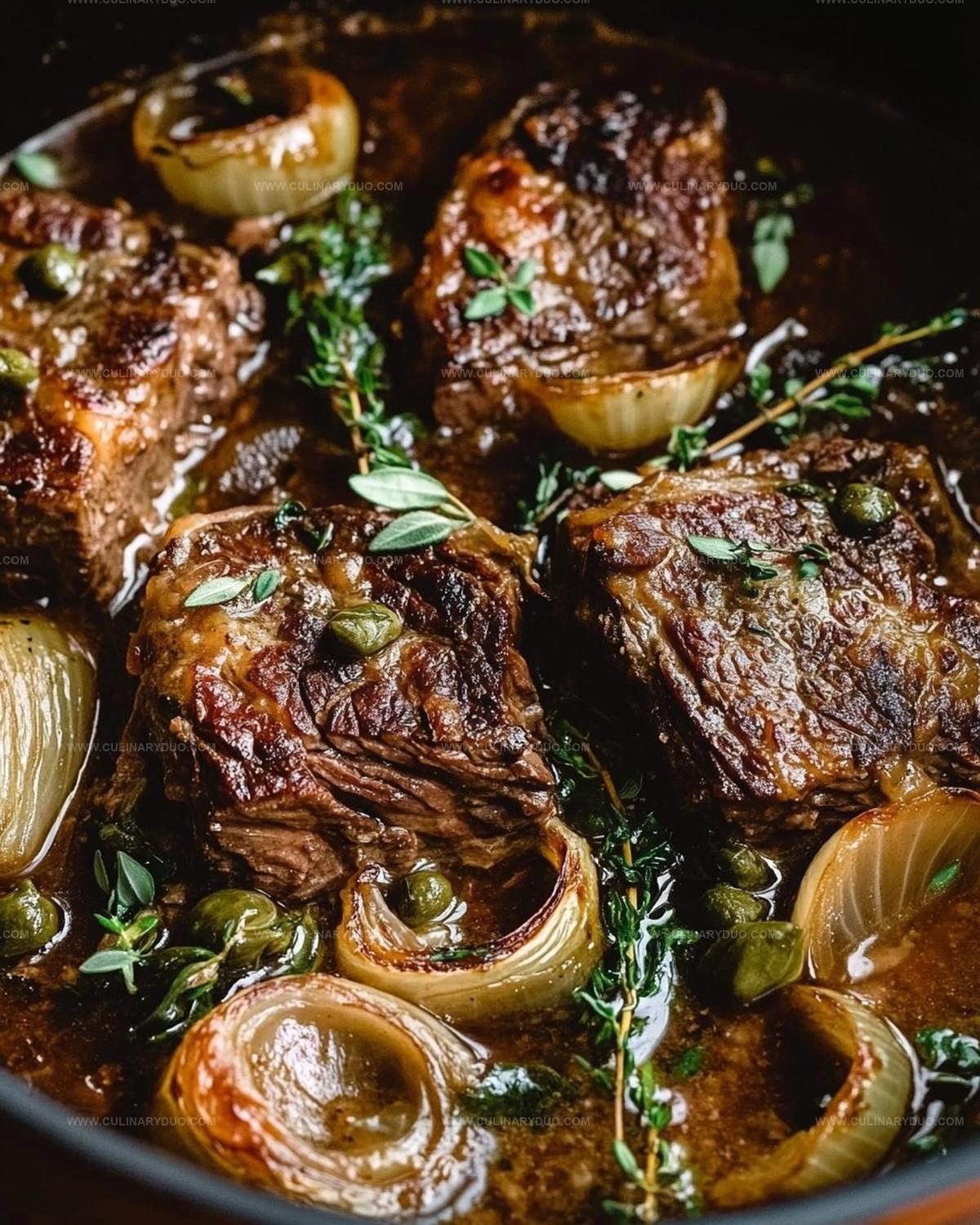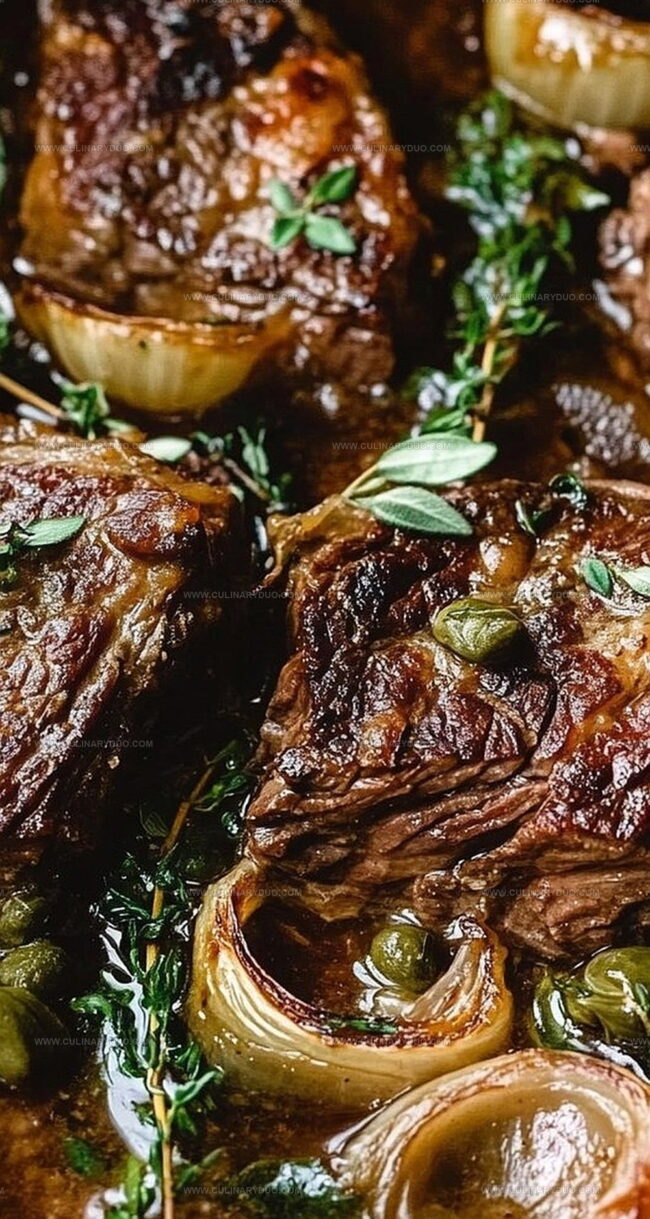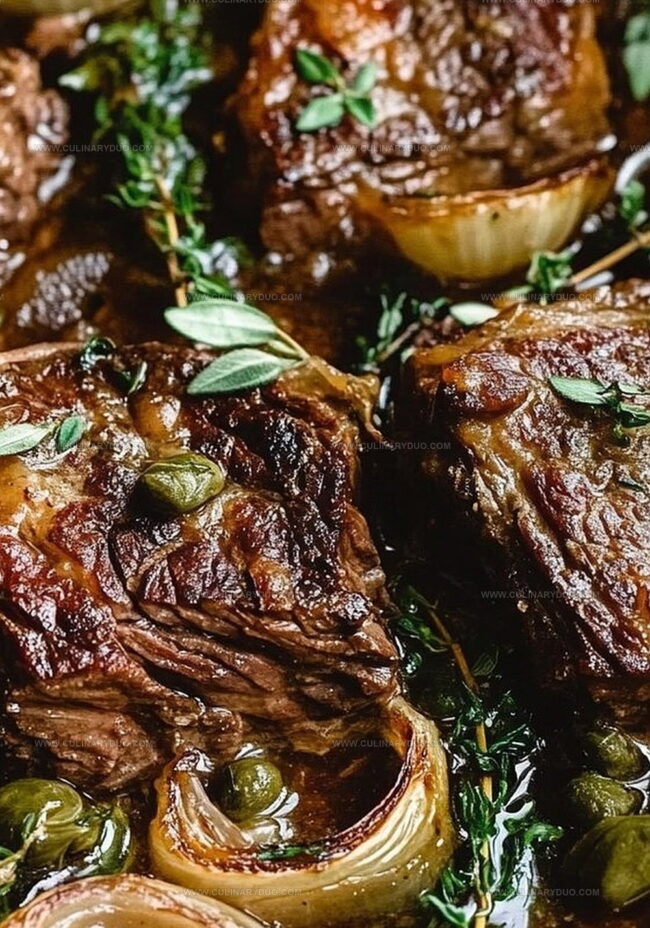The Coziest Belgian-Style Slow-Cooked Beef Stew Recipe
Cozy winter nights call for a hearty belgian-style slow-cooked beef stew that warms you from the inside out.
Robust flavors mingle in this classic comfort dish, promising a culinary adventure.
Tender meat falls apart with each spoonful, telling stories of rich tradition.
Generations have perfected this recipe, passing down secrets of slow cooking.
Aromas of herbs and slow-simmered beef will drift through your kitchen, beckoning everyone to the table.
Deep, complex notes of beer and robust spices create a symphony of taste.
Why Belgian-Style Slow-Cooked Beef Stew Is Perfect
Ingredients for Belgian Slow-Cooked Beef Stew
Meat:Aromatics and Vegetables:Liquid and Flavor Enhancers:Cooking Aids:How to Prepare Belgian-Style Slow-Cooked Beef Stew
Step 1: Prep Like A Pro
Get your kitchen ready by warming the oven to a cozy 300°F.
Slice beef into sturdy chunks.
Chop onions into thin rings and mince fresh herbs with enthusiasm.
Step 2: Sear The Beef Beautifully
Heat a heavy Dutch oven until smoking hot.
Add oil and dance those beef pieces around until they develop a deep golden-brown crust.
Work in batches to ensure perfect caramelization.
Transfer seared meat to a waiting plate.
Step 3: Transform Onions Into Flavor Bombs
Lower the heat and introduce butter to the pot.
Slowly cook onions, stirring occasionally, until they become rich, golden, and irresistibly sweet – about 15 magical minutes.
Step 4: Create Delicious Layers
Return beef to the pot and dust with flour.
Carefully construct delectable layers alternating between:Step 5: Pour In Liquid Gold
Add these flavor enhancers:Pour enough liquid to just cover the ingredients.
Step 6: Slow Cook To Perfection
Cover the pot and slide into the oven.
Let magic happen for 3 hours until beef becomes meltingly tender.
Step 7: Final Flourishes
Remove herb sprigs.
Scatter fresh chopped herbs and capers across the top for a vibrant finish.
Step 8: Serving Suggestions
Accompany with crispy Belgian fries, creamy mashed potatoes, or crusty bread.
Pour a glass of the same dark ale used in cooking.
Tips for Tender Belgian-Style Beef Stew
Flavor Twists for Belgian Beef Stew
Serving Ideas for Belgian Beef Stew
How to Store Belgian Beef Stew
FAQs
Belgian beef stew is characterized by its slow-cooking method, use of dark ale, and deep caramelization of onions, which creates a rich, complex flavor profile distinct from other beef stews.
While beef is traditional, you can substitute with lamb or pork, though the cooking time might need slight adjustments to ensure tenderness.
Searing creates a deep brown crust that develops complex flavors through the Maillard reaction, adding depth and richness to the final stew.
This stew is surprisingly forgiving. The slow-cooking method means even less experienced cooks can achieve tender, flavorful results with patience and careful layering of ingredients.
Print
Belgian-Style Slow-Cooked Beef Stew Recipe
- Total Time: 3 hours 20 minutes
- Yield: 6 1x
Description
Rich, hearty Belgian-style Beef Carbonnade offers a symphony of deep, savory flavors slow-simmered in dark Belgian beer. Dark ale and tender beef meld into a comforting classic that invites you to savor European culinary tradition with each luxurious spoonful.
Ingredients
Meat:
- 2.2 pounds (1 kilogram) chuck steak or slow-cooking beef cut
Vegetables and Herbs:
- 4 medium onions
- 1 bay leaf
- A few sprigs of thyme
- 4 tablespoons mixed fresh herbs (parsley, chives, tarragon, chervil)
Liquids and Seasonings:
- 13.5 fluid ounces (400 milliliters) dark ale
- 1 tablespoon vinegar
- 1 tablespoon oil for searing
- Water as needed to top up
Flavoring and Thickening Agents:
- 1 tablespoon butter
- 1 tablespoon brown sugar
- 1 tablespoon toasted flour
- 1 tablespoon capers
- Salt and pepper to taste
Instructions
- Prepare ingredients by cutting beef into ½-inch thick steaks. Season with salt and prepare herbs and onions for cooking.
- Heat Dutch oven on high and add oil. Sear beef steaks in batches until dark brown on both sides, ensuring pot isn’t overcrowded. Remove seared meat and cover with foil.
- Reduce heat and add butter to same pot. Cook onions for 15 minutes, stirring occasionally, until deeply caramelized and golden brown. Remove and set aside.
- Sprinkle toasted flour over beef, coating evenly. Layer pot with alternating beef, caramelized onions, and chopped herbs.
- Pour vinegar over layered ingredients. Add brown sugar, thyme sprigs, bay leaf, salt, and pepper. Pour dark ale and reserved beef juices, adding water until ingredients are just submerged.
- Cover pot and place in 300°F oven. Slow-cook for 3 hours until beef becomes incredibly tender and easily breaks apart.
- Remove thyme sprigs and bay leaf. Garnish with fresh chopped herbs and capers.
- Serve hot alongside crispy Belgian fries, creamy mashed potatoes, or crusty bread.
- For gluten-sensitive diners, substitute regular flour with gluten-free alternatives and use gluten-free ale or beef stock.
- Stew tastes even better the next day, making it perfect for advance meal preparation. Refrigerate up to 3 days or freeze for 3 months.
Notes
- Choose chuck roast or short ribs for maximum tenderness and rich flavor.
- Slowly caramelize onions to develop deep, sweet undertones that enhance the stew’s complexity.
- Pat beef dry before searing to achieve a perfect golden-brown crust that locks in juicy flavors.
- Layer ingredients carefully to distribute herbs and onions evenly throughout the stew.
- Low and slow cooking guarantees melt-in-your-mouth beef that falls apart effortlessly.
- Using dark ale adds robust depth and creates a luxurious, complex sauce with subtle malty notes.
- Allow stew to rest after cooking so flavors can fully meld and intensify.
- Optional garnishes like fresh herbs or capers brighten the rich, hearty dish.
- Prep Time: 20 minutes
- Cook Time: 3 hours
- Category: Lunch, Dinner
- Method: Slow Cooking
- Cuisine: Belgian
Nutrition
- Serving Size: 6
- Calories: 295 kcal
- Sugar: 3 g
- Sodium: 210 mg
- Fat: 15 g
- Saturated Fat: 6 g
- Unsaturated Fat: 8 g
- Trans Fat: 0.3 g
- Carbohydrates: 9 g
- Fiber: 1.5 g
- Protein: 30 g
- Cholesterol: 85 mg




Natalie Brooks
Co-Founder & Content Strategist
Expertise
Education
eCornell
Natalie brings the vibrant, plant-powered side to Culinary Duo. After earning her Plant-Based Nutrition Certificate from eCornell, she combined her love for fresh ingredients with a passion for storytelling, aiming to make healthy cooking simple and satisfying.
Her kitchen motto: good food doesn’t need a fancy label, it just needs fresh ideas and a little creativity. Outside of writing and recipe testing, Natalie’s happiest in her garden, exploring farmers’ markets, or mixing global flavors into new kitchen experiments.